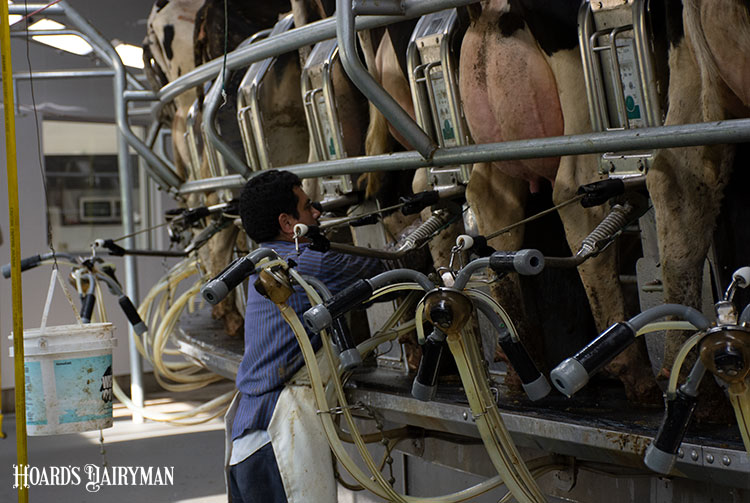
Milk is the number one crop harvested on a dairy farm. Just like how equipment settings can affect the soil of a field and the crop harvested from it, we know that how the milking procedure occurs affects the cow and the udder as well as the milk.
In addition to possible infections that can develop when a thorough milking prep routine isn’t followed, improper stimulation can prevent the cow from letting its milk down completely. This is described as “bimodal” letdown, when the milk in the teat cistern is ejected after attaching the unit, but there is a no-flow period before the majority of the milk, which resides in the gland, is let down.
Paul Virkler, a veterinarian with Cornell University’s Quality Milk Production Services, and his team have worked with many farmers to help correct this problem that he emphasizes is bad for the teats, bad for udder health, bad for the cow, and bad for milking speed.
“Now, Michigan State has also put the data on it that says we’re losing milk,” he shared about his colleagues’ research on the November 17 Hoard’s Dairyman DairyLivestream sponsored by Diamond V.
The negative effects stem from the fact that vacuum pressure on teats not filling with milk rises, and when a bimodal letdown occurs, the cow is overmilked at both the beginning and end of milking, Virkler said.
“It allows the vacuum to go up in the top of the liner of the mouthpiece chamber. So, now we set up a situation with high vacuum in the mouthpiece, and of course, we always have vacuum under the teat,” he said of the no-flow period, explaining that this creates two problems. “We start to accumulate some teat end congestion and edema. The second thing is our liner starts to move up. It pulls the teat in, but what we see is it moving toward that base [of the udder].”
Those issues both negatively impact milk flow at the beginning of milking, which is obviously not desirable when only 15% to 20% of the milk has been collected. This is often when cows start stepping around or kicking off the unit because no milk is flowing, Virkler added.
Bimodal letdown can also elevate the risk for mastitis. “These short-term changes affect how the teat canal closes when the cow goes back to the barn,” he noted.
Virkler further mentioned that bimodal milk letdown elevates the risk for teat damage if your vacuum pressure is set incorrectly. It must match the liner you’re using for the liner to operate the way it’s designed to. “Every dairy needs to know their average claw vacuum at peak flow,” the veterinarian advised.
A farm can identify if they are having bimodal let down if teats have rings, look rough, or are discolored after the unit comes off. The telltale sign would be checking if milk flow stops a few seconds after unit attachment.
To watch the recording of the November 17 DairyLivestream, go to the link above. The program recording is also available as an audio-only podcast on Spotify, Google Podcasts, Apple Podcasts, and downloadable from the Hoard’s Dairyman website.
An ongoing series of events
The next broadcast of DairyLivestream will be on Wednesday, December 8 at 11 a.m. CDT. Each episode is designed for panelists to answer over 30 minutes of audience questions. If you haven’t joined a DairyLivestream broadcast yet, register here for free. Registering once registers you for all future events.








